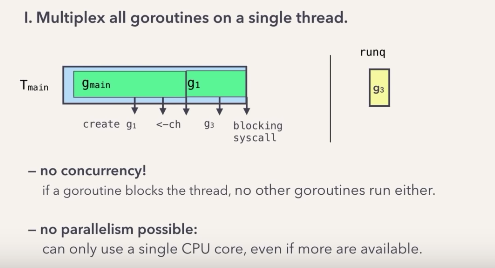Golang 调度器的演化史
什么是调度器
调度器是Golang程序的幕后的协调者(the behind-the-scenes orchestrator),假设我们有如下的一段代码:
func main() {
// Create goroutines.
for _, i := range images {
go process(i)
}
// Wait
<-ch
}
func process(image) {
// Create goroutines.
go reportMetrics()
complicatedAlgorithm(image)
// Write to file.
f, err := os.OpenFile()
}
Go调度器确保你创建的goroutine能够正确且并行的运行起来,并且在适当的时候暂停或者唤醒它们。
为什么要了解调度器
因为调度器的调度觉得可能会影响程序的性能。
为什么需要调度器
goroutines 可以视为用户态线程:
- 类似内核线程,但是由go runtime管理
- 比内核线程更轻量级;更少的内存占用(stack=2KB);创建/销毁/上下文切换更快(switch=~tens of ns)
- OS只知道内核线程,由Go调度器将goroutine放到内核线程中执行
什么时候进行调度
当有操作会影响goroutine的执行的时候, 例如:
- 创建 goroutine
- 阻塞在channel的读写
- 系统调用等等(此时线程也会阻塞)
目标
- 使用少量的线程
- 高并发: 能运行大量的goroutine
- 扩展性: 可以轻松扩展的多个CPU
两个问题
- 什么时候创建线程
- 怎样分配goroutine到线程上
1. 只使用一个线程

- 没有并发
- 不能扩展到多个CPU
2. 一个goroutine一个线程
- 违反了使用少量线程的目标
3. 线程重用
- runqueue需要一个lock, 在goroutine很多时争用
- 不能限制线程数量
4. 限制线程数量
- 线程数量应该多少: CPU数量
- 当CPU数量增加时runqueue争用出现, 不能扩展到多个CPU
测试数据:
- 4core: 4x
- 16core: 31x, worth
解决方式:
- one runqueue per thread
- steal from other runqueue, balance work
仍然存在的问题:
- g block 时会 block thread
- monitor 线程可以把block thread runqueue 给其他thread
- 为什么不是自己线程? 不知道 block 时间长度
- 需不需要重新启动线程?现在是限制了线程数量, 但是有一个block了,相当于可用数量变少
- monitor 启动新线程,这时持有 runqueue 的就是 P,限制的是P的数量
最终
- limit #(goroutine-running) thread to CPU cores (GOMAXPROCS)
- reuse threads
其他问题
- 非抢占: cpu bound 型的; sysmon 检测运行了(> 10ms)的并停下它(设置可停止标记, 在下次stack扩容时停下), 放到 global runqueue(lower priority)
- no goroutine priorities
- no strong preemption: no strong fairness or latency guarantees: Non-cooperative goroutine preemption
- is not aware of the system topology: NUMA-aware scheduler